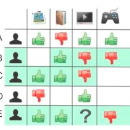Graph neural networks (GNNs) have shown the power in representation learning over graph-structured user-item interaction data for collaborative filtering (CF) task. However, with their inherently recursive message propagation among neighboring nodes, existing GNN-based CF models may generate indistinguishable and inaccurate user (item) representations due to the over-smoothing and noise effect with low-pass Laplacian smoothing operators. In addition, the recursive information propagation with the stacked aggregators in the entire graph structures may result in poor scalability in practical applications. Motivated by these limitations, we propose a simple and effective collaborative filtering model (SimRec) that marries the power of knowledge distillation and contrastive learning. In SimRec, adaptive transferring knowledge is enabled between the teacher GNN model and a lightweight student network, to not only preserve the global collaborative signals, but also address the over-smoothing issue with representation recalibration. Empirical results on public datasets show that SimRec archives better efficiency while maintaining superior recommendation performance compared with various strong baselines. Our implementations are publicly available at: https://github.com/HKUDS/SimRec.
翻译:图形神经网络(GNNs)已经展示了基于图结构的用户-物品交互数据的表示学习在协同过滤(CF)任务中的优越性。然而,由于递归信息传播,使用低通拉普拉斯平滑算子时,现有的基于GNN的CF模型可能会产生不可区分和不准确的用户(物品)表示,因此会产生过度平滑和噪声效应。此外,整个图结构中堆叠聚合器的递归信息传播可能导致实际应用中的可扩展性差。受这些局限的启发,我们提出了一个简单而有效的协同过滤模型(SimRec),将知识蒸馏和对比学习的优势结合起来。在SimRec中,启用了教师GNN模型和轻量级学生网络之间的自适应转移知识,不仅可以保留全局协作信号,还可以通过表示重新校准来解决过度平滑问题。公共数据集上的实证结果表明,与各种强基线相比,SimRec实现了更好的效率,同时保持了卓越的推荐性能。我们的实现已经在https://github.com/HKUDS/SimRec公开。





